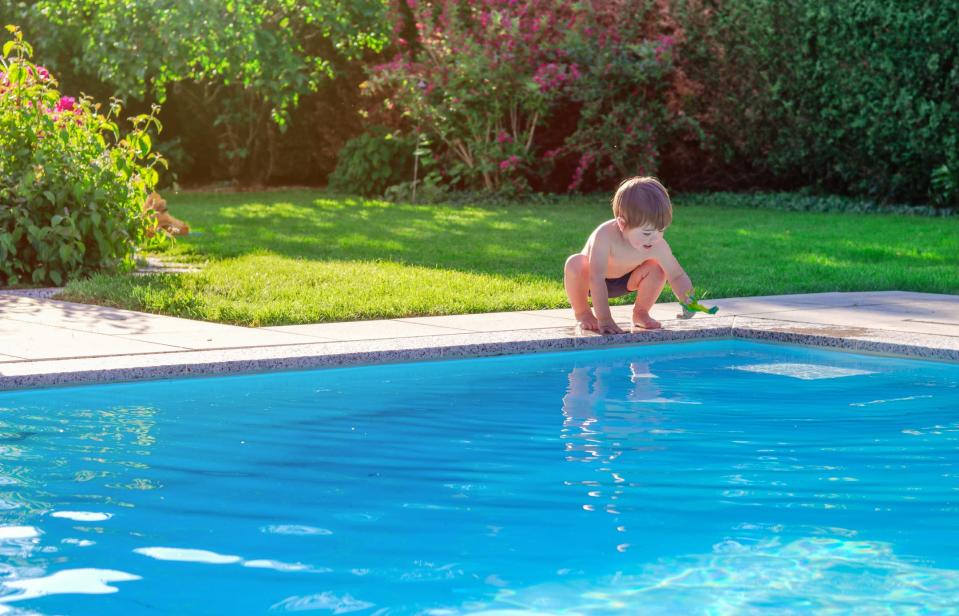Drowning is a top cause of death for young children. Here's what parents should know.
Summer is nearly here, which means families will be heading to pools for fun and relief on hot-weather days. But it's also a good time to revisit ways to keep kids safe so those joyful days don't turn into tragedy.
May is National Drowning Prevention Month intentionally because it's right before pools and lakes open up around the country. Drowning is a leading cause of death in childhood, especially for children under 4 years old, the American Academy of Pediatrics states, and 69% of those drownings happen during non-swim times, according to Modern Pediatrics.
Though early exposure to water and swimming is important for water safety, there are other measures parents should take to prevent the worst outcomes possible at home, on vacation or near a pool or other bodies of water.

Here are tips parents and caregivers should follow to help prevent drownings.
Water safety at home
Babies can drown in as little as one inch of water, so of course, never leaving a child unattended is the most important rule to follow.
It can be beneficial to learn CPR if you do find yourself in an emergency situation. The American Red Cross has detailed instructions on how to administer CPR on toddlers and babies safely.
It can be hard to monitor everything at once, especially when you have multiple kids. But there are more steps you can take to help prevent drowning.
Safe Kids Worldwide, a nonprofit organization working to reduce unintentional injuries to children, shares the following tips for water safety at home:
Empty all tubs, buckets, containers and kids' pools immediately after use and store them upside down out of reach.
Keep lids to toilets and doors to bathrooms and laundry rooms closed when not in use.
Install fences at least 4 feet tall with self-closing and self-latching gates around pools.
Stop Drowning Now suggests installing alarms on the house door that leads to the pool area. You can also purchase a floating pool alarm or a below-water alarm in the pool. An alarm isn’t a substitute for appropriate fencing and supervision, but it can help.
Keep rescue equipment (such as a shepherd's hook or life preserver) and a telephone by the pool, the Arc of California states.
Water safety when at a public pool
The National Drowning Prevention Alliance outlines five layers of protections for safely enjoying a day at a public pool with young kids, especially those under 5 years of age.
"Drowning is fast, silent and not what you'd expect," the NDPA states. "And it can happen in as little as 30 seconds – about as long as it takes to reply to a text message."
Drowning is preventable with the following layers of protection:
Exposure to water can reduce the risk of drowning for up to 90% for children ages 1 to 4, the NDA states. Infant swim lessons are so important. Children can learn to float and then swim, applying an added layer of security for if they ever fall in.
For kids who lack water competency, life jackets are non-negotiable.
When around a pool, make sure there's a designated water watcher, whose sole job it is to watch the kids around water.
Water safety around natural bodies of water
Family fun at lakes and other natural bodies of water are memories to hold on to, because they usually involve celebrations, holidays and larger family gatherings. That's why it's extra important for parents to be mindful of keeping their eyes on their kids. Do not consume too much alcohol while supervising children.
As previously stated, knowing CPR is important for safety purposes, and for outdoor adventures specifically, here are some things to keep in mind from Massachusetts Injury Prevention and Control program:
Make sure your child has a U.S. Coast Guard-approved life jacket on when around water. Do not use air-filled or foam toys such as "water wings," "noodles" or inner tubes, in place of life jackets.
Teach kids that it is dangerous to play rough or climb on each other in the water.
Select swimming sites that have lifeguards whenever possible, but keep in mind that a lifeguard is there to enforce rules, scan the area and provide rescue intervention. They cannot watch each child.
Whenever infants and toddlers are in or around water an adult should be within an arm's length at all times providing "touch supervision."
Don’t let your child swim in an area with strong moving currents in the water.
This article originally appeared on USA TODAY: Child drowning prevention tips: Keeping kids safe around pools, lakes

